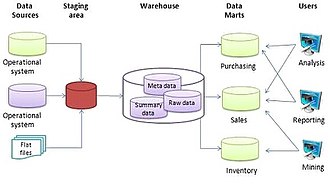Data warehouse



Data Warehouse is a system used for reporting and data analysis, and is considered a core component of business intelligence. Data warehouses are central repositories of integrated data from one or more disparate sources. They store current and historical data in one single place that are used for creating analytical reports for workers throughout the enterprise.
The data stored in the warehouse is uploaded from the operational systems (such as marketing, sales, etc.). The data may pass through an operational data store and may require data cleansing for additional operations to ensure data quality before it is used in the DW for reporting.
Overview[edit]
A data warehouse maintains a copy of information from the source transaction systems. This architectural complexity provides the opportunity to:
- Consolidate data from many sources into a single database so a single query engine can be used to present data.
- Classify data according to the subject and give access according to those divisions.
Architecture[edit]
The typical Data Warehouse architecture consists of the following tiers:
- The database server, where data is loaded and stored.
- The middle tier, consisting of the analytics engine that is used to access and analyze the data.
- The front-end client tier, which includes reporting tools, analysis tools, and/or data mining tools.
Types of Data Warehouses[edit]
There are mainly three types of data warehouses:
- Enterprise Data Warehouse (EDW): Provides a centralized, consolidated database for the entire organization.
- Operational Data Store (ODS): Has a more operational perspective and is updated in real-time.
- Data Mart: A subset of a data warehouse, focused on a particular line of business, department, or subject area.
Data Warehouse Technologies[edit]
Data warehouse technology includes:
- Database systems
- Extraction, Transformation, and Loading (ETL) tools
- Online Analytical Processing (OLAP) engines
- Client reporting tools
- Data mining tools
Benefits[edit]
The key benefits of a data warehouse include:
- Improved business intelligence
- Enhanced data quality and completeness
- Historical intelligence
Challenges[edit]
However, data warehouses also face several challenges:
- Data integration from disparate sources
- High costs for data storage and management
- Ensuring data quality and consistency
Future Trends[edit]
With the advent of big data and cloud computing, the future of data warehouses is evolving towards:
- Cloud-based data warehouses
- Real-time data processing
- Increased focus on data governance and security
Ad. Transform your life with W8MD's Budget GLP-1 injections from $75


W8MD offers a medical weight loss program to lose weight in Philadelphia. Our physician-supervised medical weight loss provides:
- Weight loss injections in NYC (generic and brand names):
- Zepbound / Mounjaro, Wegovy / Ozempic, Saxenda
- Most insurances accepted or discounted self-pay rates. We will obtain insurance prior authorizations if needed.
- Generic GLP1 weight loss injections from $75 for the starting dose.
- Also offer prescription weight loss medications including Phentermine, Qsymia, Diethylpropion, Contrave etc.
NYC weight loss doctor appointmentsNYC weight loss doctor appointments
Start your NYC weight loss journey today at our NYC medical weight loss and Philadelphia medical weight loss clinics.
- Call 718-946-5500 to lose weight in NYC or for medical weight loss in Philadelphia 215-676-2334.
- Tags:NYC medical weight loss, Philadelphia lose weight Zepbound NYC, Budget GLP1 weight loss injections, Wegovy Philadelphia, Wegovy NYC, Philadelphia medical weight loss, Brookly weight loss and Wegovy NYC
|
WikiMD's Wellness Encyclopedia |
| Let Food Be Thy Medicine Medicine Thy Food - Hippocrates |
Medical Disclaimer: WikiMD is not a substitute for professional medical advice. The information on WikiMD is provided as an information resource only, may be incorrect, outdated or misleading, and is not to be used or relied on for any diagnostic or treatment purposes. Please consult your health care provider before making any healthcare decisions or for guidance about a specific medical condition. WikiMD expressly disclaims responsibility, and shall have no liability, for any damages, loss, injury, or liability whatsoever suffered as a result of your reliance on the information contained in this site. By visiting this site you agree to the foregoing terms and conditions, which may from time to time be changed or supplemented by WikiMD. If you do not agree to the foregoing terms and conditions, you should not enter or use this site. See full disclaimer.
Credits:Most images are courtesy of Wikimedia commons, and templates, categories Wikipedia, licensed under CC BY SA or similar.
Translate this page: - East Asian
中文,
日本,
한국어,
South Asian
हिन्दी,
தமிழ்,
తెలుగు,
Urdu,
ಕನ್ನಡ,
Southeast Asian
Indonesian,
Vietnamese,
Thai,
မြန်မာဘာသာ,
বাংলা
European
español,
Deutsch,
français,
Greek,
português do Brasil,
polski,
română,
русский,
Nederlands,
norsk,
svenska,
suomi,
Italian
Middle Eastern & African
عربى,
Turkish,
Persian,
Hebrew,
Afrikaans,
isiZulu,
Kiswahili,
Other
Bulgarian,
Hungarian,
Czech,
Swedish,
മലയാളം,
मराठी,
ਪੰਜਾਬੀ,
ગુજરાતી,
Portuguese,
Ukrainian


